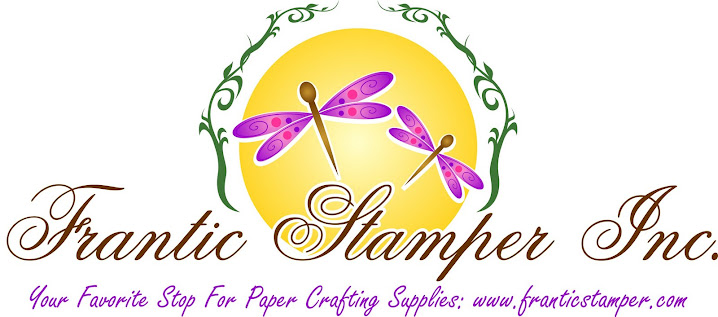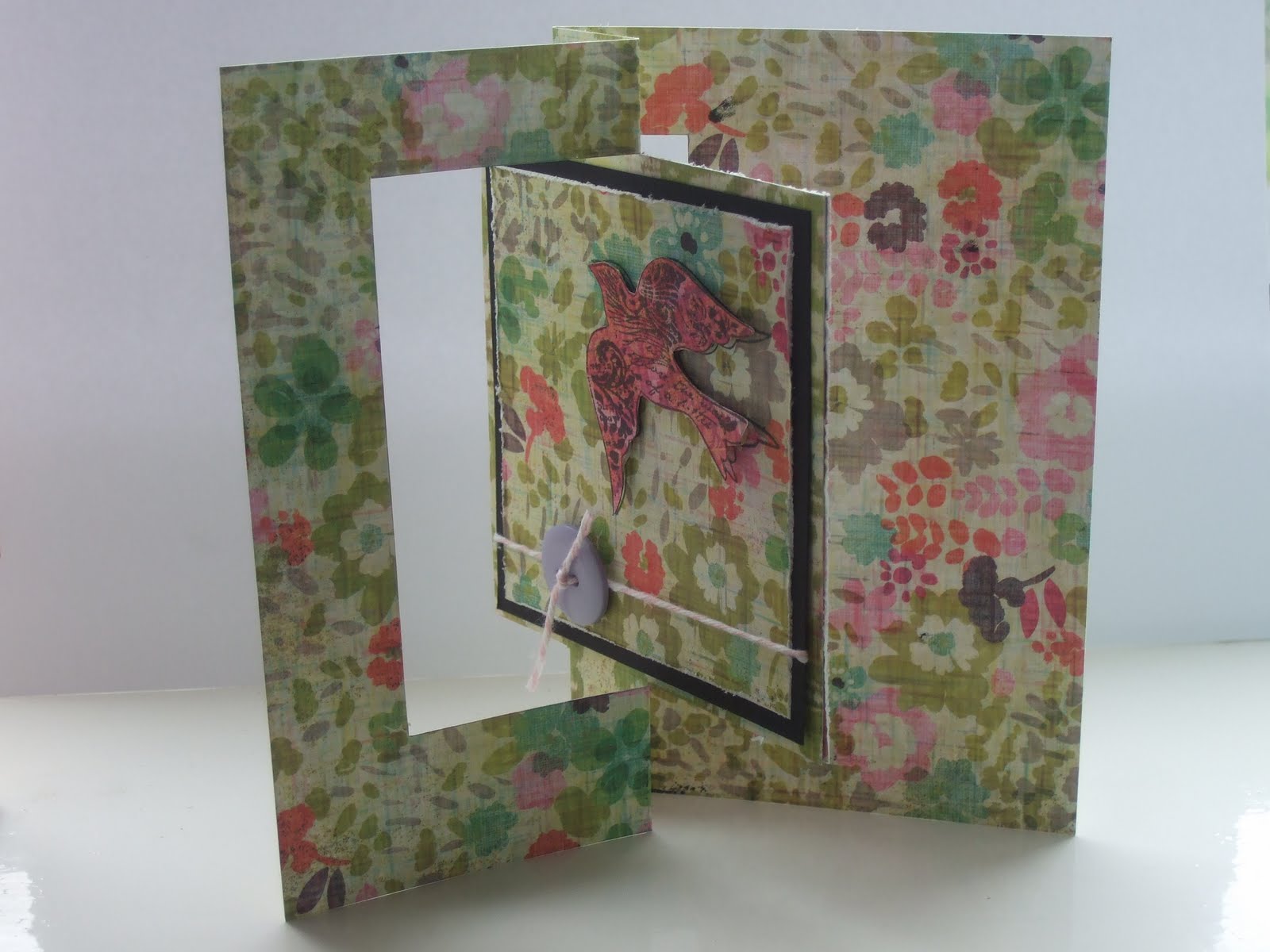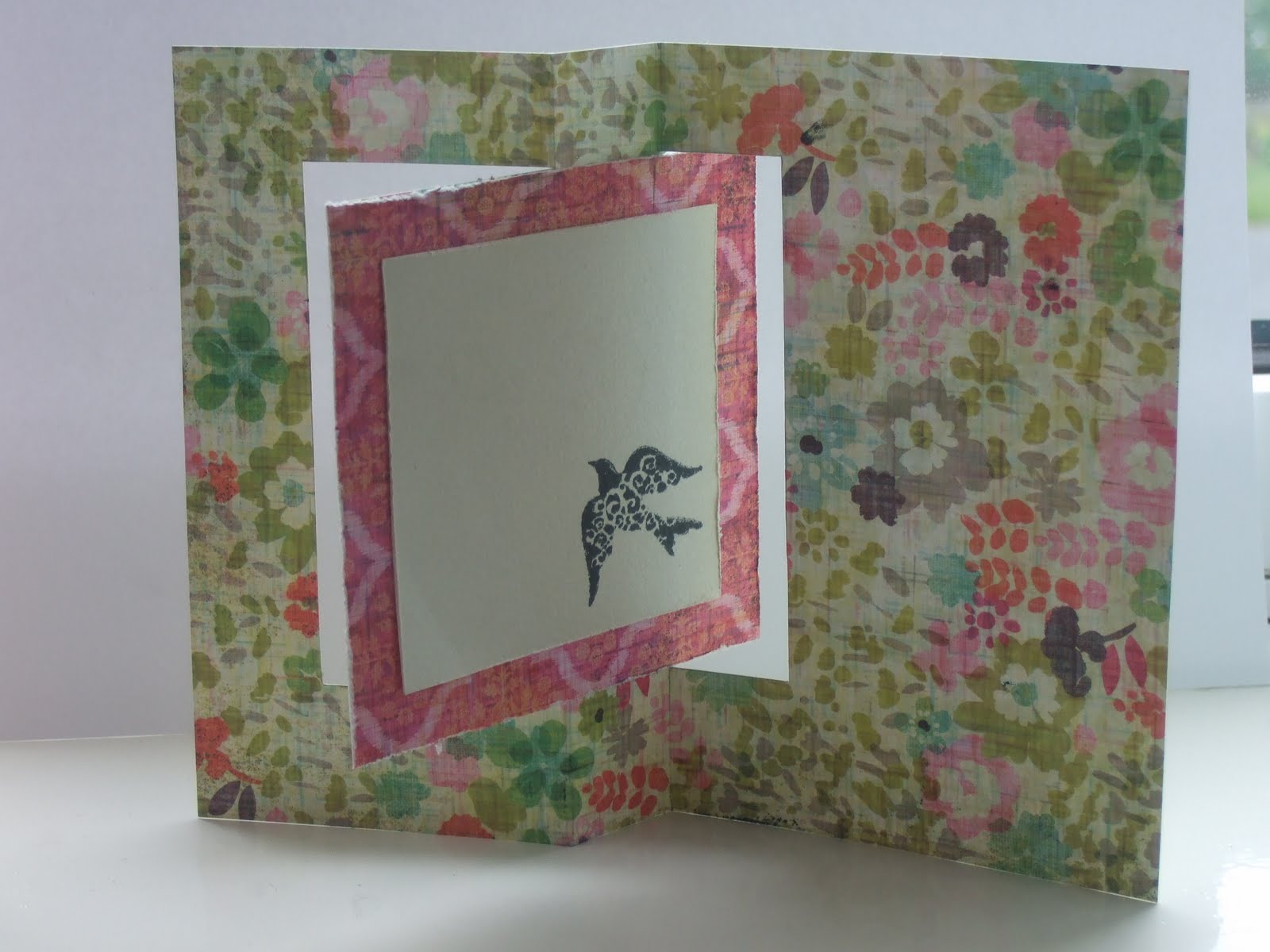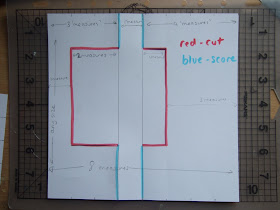

by Kathy Berger
Embossing Folders
First, I would like to apologize a little for the length of this post. I am sure I am going to overwhelm some of our readers, but I really wanted to be as thorough as I could about using embossing folders; perhaps I should have done this across several posts, but I really wanted to provide you with a single reference. I hope you will forgive my transgression and read through the post, or at least bookmark it for future reference.
This post is not necessarily intended as an exhaustive guide for using those folders, but I hope it will be thorough enough to help you to get more out of the folders you might already have, and perhaps encourage you to buy more (check out the huge selection of folders available at
FranticStamper!
Using an embossing folder is as simple as inserting the material to be embossed into the folder, building up the appropriate sandwich for the machine being used, and rolling the folder through the machine (by cranking, pumping, or turning on a switch, depending on the machine.)
Here is a summary of the standard sandwiches for using the embossing folders with a variety of die cutting machines. Machines do have some variation in the tightness of their sandwiches. You may need to add shims or vary your sandwich for your particular machine. One rule to remember is never to force a sandwich into your machine... you might break your plates and potentially could damage your machine. Always be sure to follow your manufacturer's guidelines!
Machines and sandwiches:
| Machine | Sandwich |
|---|
| Cuttlebug | White A Plate
B Clear Cutting Plate
Cuttlebug Embossing Folder
B Clear Cutting Plate |
| Wizard | Blue Mat
Cuttlebug Embossing Folder
Tan Embossing Pad
White Mat
|
| Original Sizzix | Standard Cutting Plate
Cuttlebug Embossing Folder
Sizzlet Machine Concerter in place on machine
|
| Big Shot | Multi-Purpose Platform, open at Tab 1
Clear Cutting Pad
Cuttlebug Embossing Folder
Clear Cutting Pad
|
| QuickCutz Epic | Gray Cutting/Embossing Platform
Cuttlebug Embossing Folder
Clear Cutting Mat
|
| Vagabond | Solo Platform
Shim
Standard Cutting Mat
Cuttlebug Embossing Folder
Standard Cutting Mat
|
| Craftwell eBosser | Plate D
Plate C
Cuttlebug Embossing Folder
Plate A |
Throughout this tutorial, if you wish to see a photo closer up, you can click on the photo to open it at a larger size then use your browser's back button to return to the tutorial page, or right-click (ctrl-click on a Mac) to choose to open the photo in a different tab or window.
Next, here is a little warning about your choice of materials for embossing...if your material has a right side and a wrong side it is important to always be sure to insert it into the folder correctly! In general, the right side should be against the side which has the pattern indented rather than against the side whose pattern is raised; the embossing (raised pattern) will end up on the right side and the debossing (indented pattern) on the wrong side.
Embossing Different Materials
- Vellum
Vellum is beautiful when embossed, but it is a little bit fragile and sometimes tears or breaks when embossing. I find that if I sandwich the velum between two pieces of text-weight paper before inserting into the folder I have better results.

- Transparencies
Getting a photo of an embossed transparency is definitely difficult, but the embossing is child's play; simply insert the transparency into a folder and emboss as you would card-stock! The results are fabulous even when the photo isn't!

- Metal
Only thin metals (foils and foil card stock are wonderful!) should be embossed; thicker metals can damage not only your folder, but also your machine! The metal I used is aluminum from a soft drink can.
Note: thin metals can be die cut with steel rule dies like the original Sizzix dies before embossing. These flowers were cut with a small (green) Sizzix Originals die.

Also try embossing flashing tape (not to be confused with duct tape!); it is very metalic looking, embosses easily, and is self-adhering!

By the way, once embossed metals can be colored with alcohol inks for a wonderful effect!
- Chipboard
Chipboard can be difficult to emboss because it is stiff and it is thick. Only thin chipboard (the weight of a cereal box) should be used in the folders.

Thin coasters can be embossed in the same way as chipboard.

- Velvet paper
Velvet or suede papers can be embossed with a beautiful yet subtle result. These specialty papers are less stiff than standard cardstock but still hold the embossing beautifully.

- Craft foam
While it is possible to emboss craft foam it is difficult to get a good, deep emboss. It helps some if you HEAT the embossing foam prior to embossing, but to do so you need to work quickly. Use a heat tool to heat the foam and as soon as the foam starts to curl, place the foam into the folder and run immediately through the embossing machine. This is one case where having an extra set of hands would be a BIG help (I didn't have extra hands so this is not as deeply embossed as I would like.)

Embossing, Plus Color
- It is easy to emboss anything that has already been colored. Add texture to your patterned papers or your stamped and colored images by embossing them! But here are some other ways to combine color and texture by using embossing folders.
- DTP
Using a light touch, simply rub an ink pad across the embossed image. Color will transfer to the raised parts of the image.

- Chalk
Apply chalk to the embossed areas of the card; smudge and rub in lightly. For this technique I use Stabilo CarbOthello Pastel Pencils I had from an old art class, but any quality art chalk, like the Pebbles and Craft chalks at FranticStamper, will work well. Use a white polymer eraser to remove stray chalk or to lighten areas if desired.

- Gel Pen Highlights
Use a gel pen to trace around all or parts of the embossed image to add highlights (especially effective on colored papers!)

- Using Waxed Paper for a Resist
Emboss a piece of waxed paper as you would any other piece of paper. Place the embossed piece onto a piece of card stock. Cover with a sheet of typing bond, and iron on high temperature (NO STEAM!) to transfer the wax to the glossy card stock. Sponge or brayer ink onto the card, and then buff off the excess ink with a rag or piece of paper towel. The pattern from the embossing folder will have transferred to the glossy card, and will act as a resist to the ink.

- Sanding white core paper
Emboss white core or double sided papers as usual. (Using Core'Dinations cardstock for this technique is fabulous! A wide selection of Core'Dinations is available at FranticStamper .) Use a sanding block to lightly sand away the top of the embossed areas of the paper. Sand away a little, or a lot, depending on the look you are after.

- Ink the folder
Rub dye based, pigment, or chalk ink directly onto the inside of the embossing folder from the ink pad (do not use permanent or solvent based inks as they will not transfer well and will not come off the folder.) Rub onto the flatter side of the folder, the side with the indentations of the pattern. When embossed the ink will become the background for the embossed images.

Partial Embossing
- Back out
Roll the sandwich only part way through the machine and then back the folder out.
Note: all of the manual machines have a method for reversing direction of the sandwich's progress through the machine. On the Cuttlebug, for example, simply turn the crank in the reverse direction.)

- Small folders
Use a piece of Spellbinder's tan embossing mat (this stuff cuts easily!) or a chipboard shim (you might need a couple of layers) just a little smaller than the folder to replace one of the plates in your sandwich (on a Cuttlebug the sandwich would be A plate, folder with cardstock inserted, embossing mat or shim, and C plate... experiment with your machine's sandwich). The embossing will only happen where the mat or shim makes contact with the embossing folder, preventing the edges of the folder from being embossed.

Note: This selective embossing technique can be used to emboss a shape or a window. Simply cut a shape out of chipboard and use with a full-sized embossing folder to emboss only the shape. Here are a rectangular frame and a circular shape embossed with the Swiss Dots folder.


Long Embossing
To emboss a long strip of paper that is no more than 5" wide you can use one of the A2-sized folders that has a repeating pattern (Swiss Dots, for example). The preferred method uses a piece of the Spellbinder's tan embossing mat, just a little smaller than the A2 Folder, and a C plate.
Place the paper in the folder so that the top edge is inside the patterned area. Place the folder SIDEWAYS onto the A plate on the base of the embossing machine so that the bottom edge of the paper extends beyond the end of the plates. Put the embossing mat on top of the folder, then put the C plate on top of it all to complete the sandwich. Roll through the machine.
Remove the paper from the folder then reposition the paper so that you will emboss an un-embossed area; carefully align the end of the embossed area onto the pattern of the folder. You will be able to feel it almost "lock" into place.
Rebuild the sandwich, pass through the machine and then repeat until the entire strip is embossed.
Alternately, you can use the standard sandwich (A plate, B Plate, folder, B plate) with the same repetitive process. The difference is that the B-plate will cause the edges of the folder to flatten out a small amount of the pattern that previously has been embossed. First emboss all the way across the strip, ignoring this flattening effect. When the whole strip has been embossed, simply align the paper onto the raised side of the pattern of the embossing folder and rub your fingers around the area that had been flattened, applying slight pressure. You will cause the previously embossed area to push into the pattern, and the embossing will re-imerge. Repeat this on any flattened areas. The strip (2 1/4" x 12") in the photo was embossed with this method.

Double embossing
This technique involves using two different embossing folders and inking, and can use either of a couple of the coloring methods discussed above. The ink will highlight the first folder's pattern, while the texture will show the second.
- Ink positive
Emboss your first folder and use the DTP method to add color to the raised image. Next, emboss with the second folder.

- Ink negative Use the Ink the folder method with the first folder to add color to the background of the raised image. Then emboss using the second folder. The texture of the second folder will be the only texture left on the cardstock, but the negative of the pattern of the first folder will be printed on the cardstock.

I hope you have enjoyed at least some of this lengthy post and perhaps have found it useful. I promise to try to make my next technique post a little less involved!
(Be sure to check out
this article by Sharon Jeffs for more examples of these techniques, plus a few more techniques!)
Smiles,
Kathy












 by Joanne Wardle
by Joanne Wardle















































